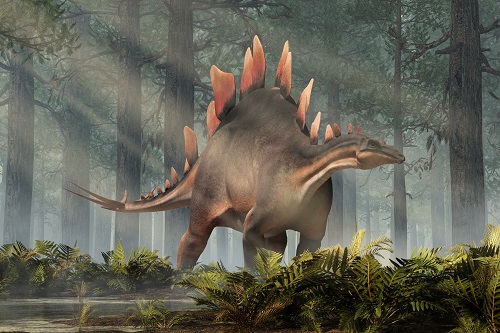Jurassic era
The Jurassic period, spanning from 201 to 145 million years ago, is truly mind-boggling in its vastness. When compared to the relatively short existence of humanity, which has been around for about 125,000 years, the Jurassic period endured for approximately 450 times longer.
During the early stages of the Jurassic period, the supercontinent Pangaea began to break apart, leading to the formation of multiple land masses. Over millions of years, these land masses continued to separate, creating new opportunities for the emergence of diverse animal and plant species. This geographical transformation had two significant impacts. Firstly, the reduction in desert environments allowed for more widespread habitats, as most smaller land masses were consistently surrounded by water. This led to more favorable and diverse climates, fostering the proliferation of life. Secondly, the separation of continents resulted in the isolation of different groups of dinosaurs and other animals. This isolation allowed for independent evolutionary paths, leading to the development of distinct species over time.
The Jurassic period was a time of remarkable transformations, setting the stage for the diversity of life that would continue to evolve throughout Earth’s history.

Bloom time for the dinosaurs
The Jurassic period was a favorable time for dinosaurs, as they rose to become the dominant group of animals worldwide. With the extinction of their main competitors, such as the archosaurs, during the transition from the Triassic to the Jurassic, dinosaurs had the opportunity to thrive and diversify. Abundant food resources allowed herbivorous dinosaurs to grow larger and larger, resulting in the emergence of remarkable species like the towering Brachiosaurus, reaching heights of up to 15 meters. The increase in herbivore size also provided ample food for carnivorous dinosaurs, driving their growth as well. The carnivores had to be large and strong to successfully take down sizable herbivores. A single Brachiosaurus could sustain large carnivorous dinosaurs for weeks!
Not only did land-dwelling dinosaurs experience remarkable growth during the Jurassic period, but the oceans also saw the emergence of new and large species. Many pre-existing marine species had become extinct by the end of the Triassic, opening up ecological niches for new marine life in the Jurassic. One notable example is the Plesiosaurs, marine reptiles characterized by their long necks and large flippers. These impressive creatures could grow up to 15 meters in length. It is interesting to note that the iconic Loch Ness monster, often depicted as resembling a plesiosaur, captures the imagination and fascination surrounding these ancient sea-dwelling creatures.
Jurassic Park
The Jurassic era holds a special place in popular culture, thanks to the iconic Jurassic Park film franchise named after it. Many of the dinosaurs featured in these films lived during the Jurassic period. Since the release of the first Jurassic Park movie in 1993, dinosaurs have captured the imagination of people around the world, leading to increased interest and knowledge about these fascinating creatures.
The Jurassic period came to a close approximately 201 million years ago, marking the beginning of the Cretaceous period. Although a mass extinction event occurred at the end of the Jurassic, it was not as severe as the one that marked the beginning of the Jurassic. This extinction event was primarily driven by significant climate changes, with sudden shifts towards either warmer or colder conditions. Despite this event, dinosaurs persisted as the dominant species and continued to thrive throughout the subsequent Cretaceous period.

Follow us on TikTok
Wondering what your dino-friends get up to when you’re not around? Follow the adventures of your favourite dinosaurs on TikTok and other social media platforms!
Follow us on social media